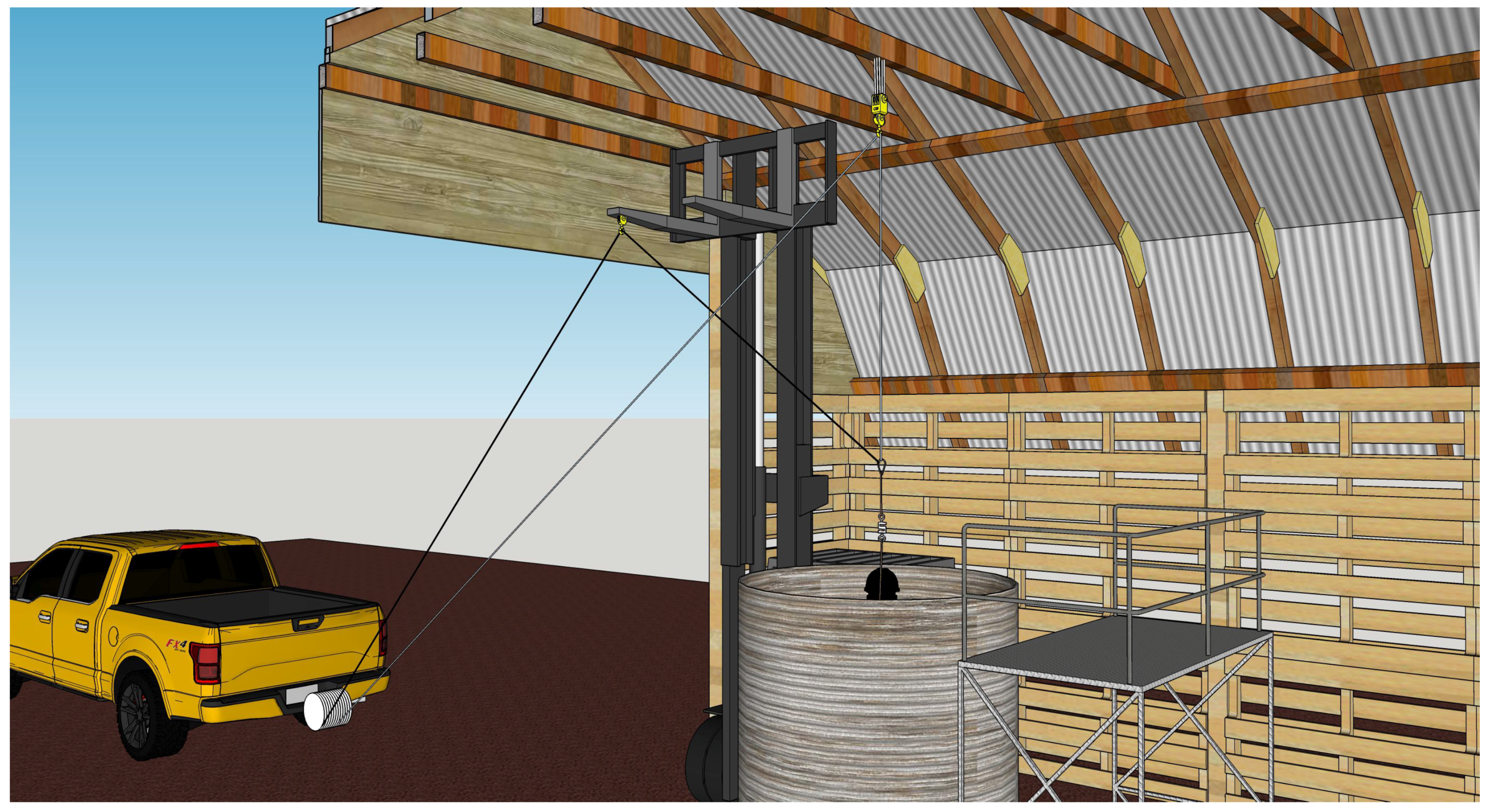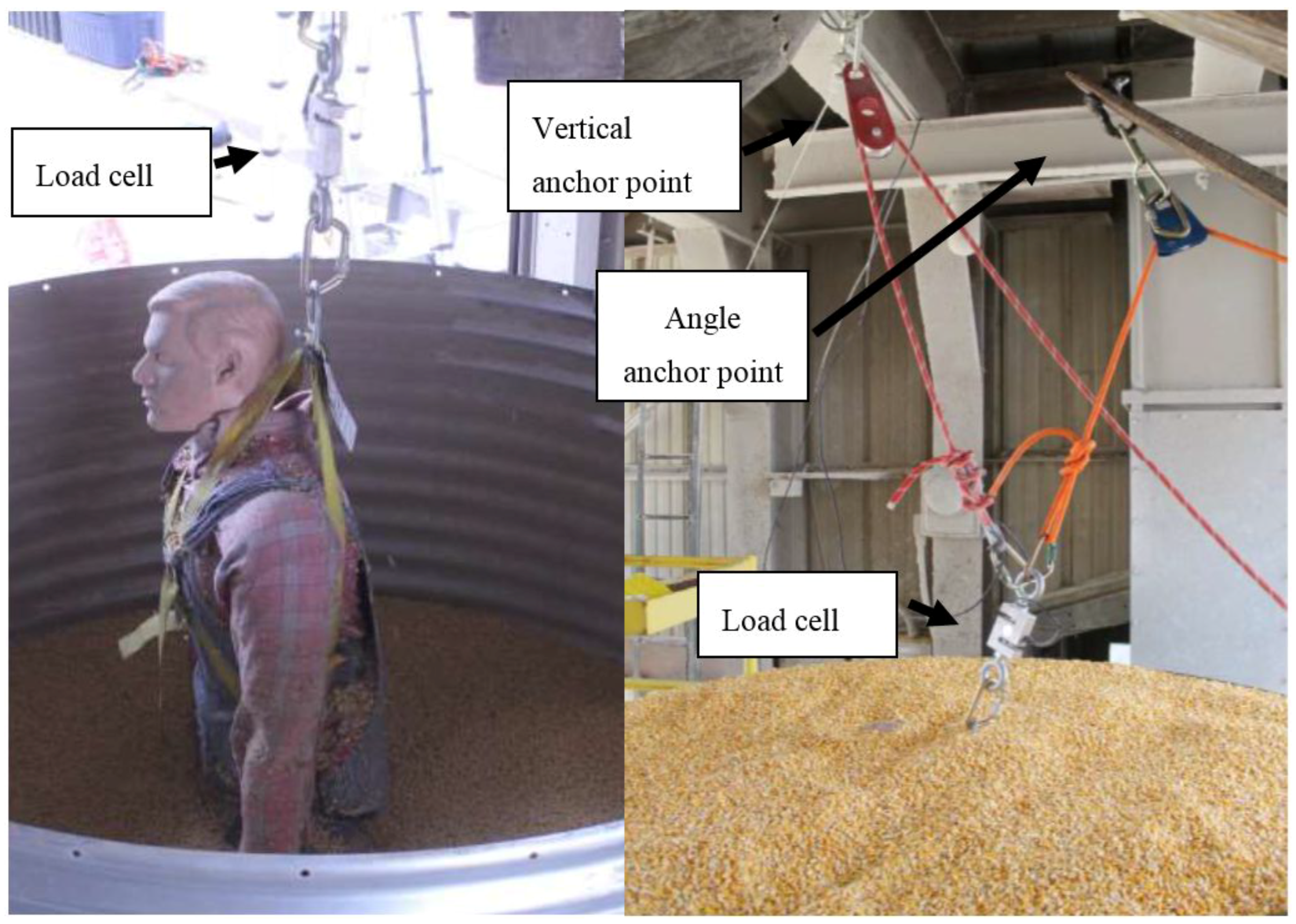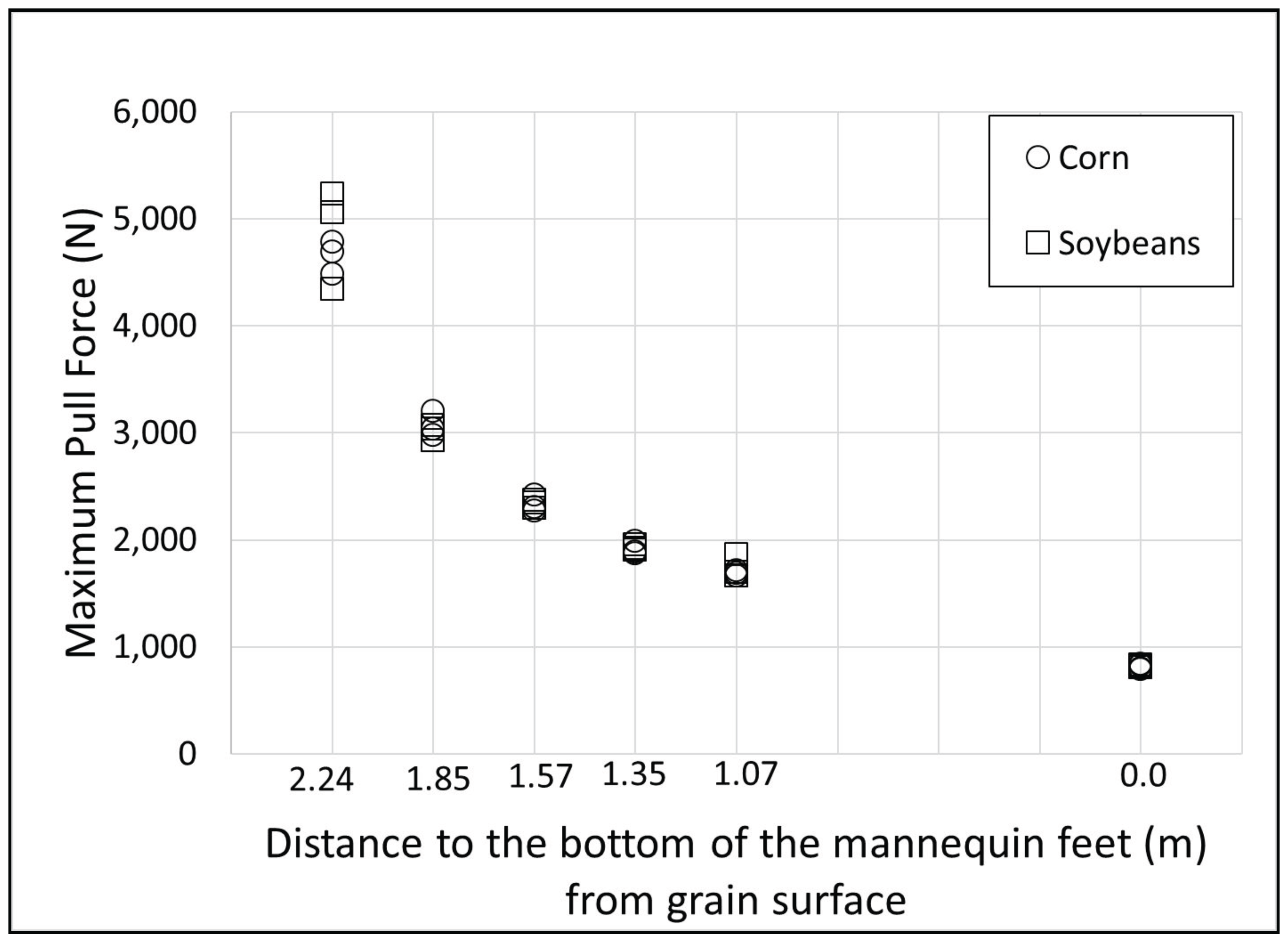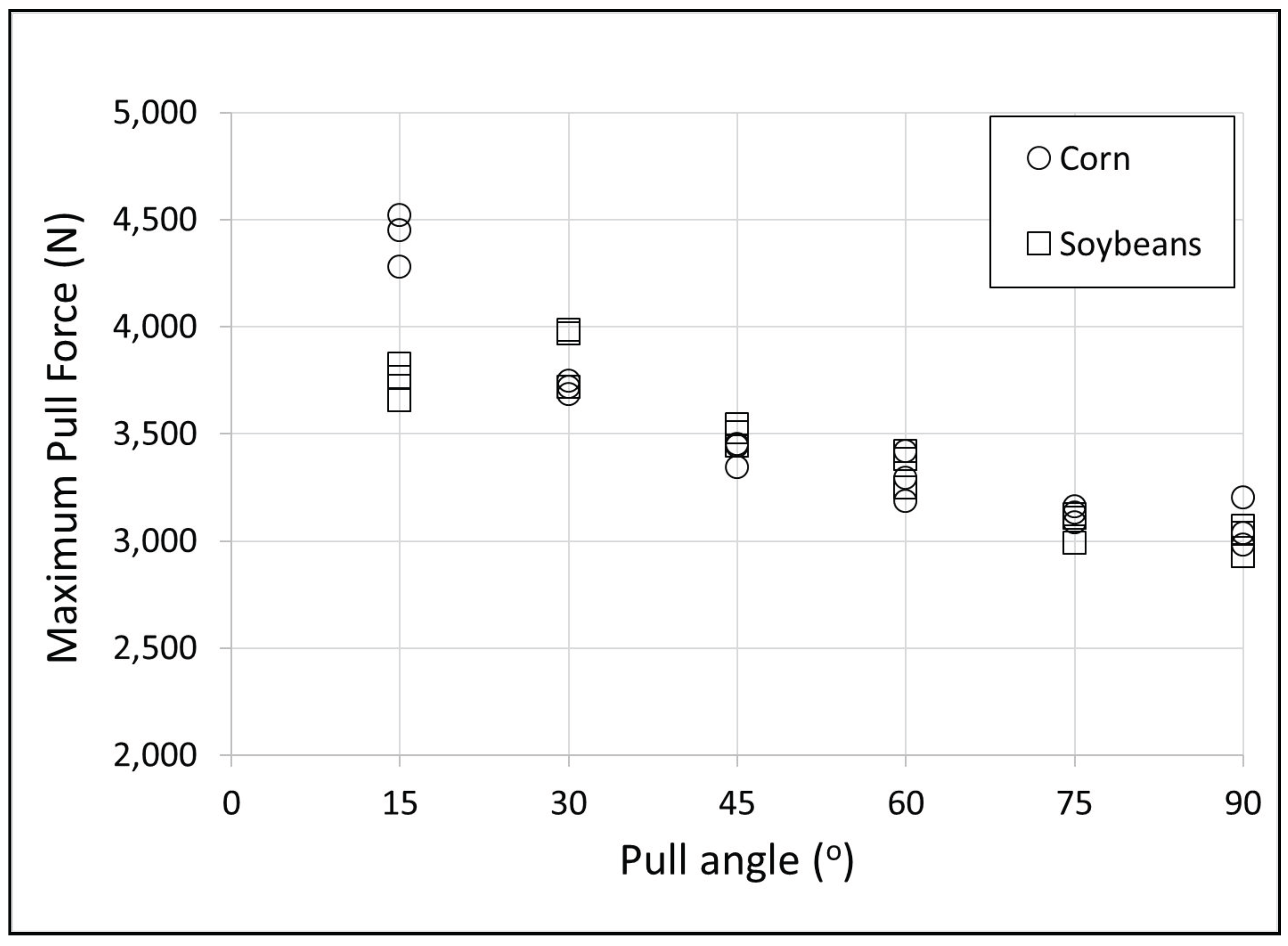Determining the Pull-Forces Required to Extricate a Victim Entrapped at Various Angles in a Grain Mass
Abstract
:1. Introduction
2. Materials and Methods
2.1. Experiment Setup
2.2. Experiment Design
2.2.1. Vertical-Pull Experiment
2.2.2. Angled-Pull Experiment
3. Results
3.1. Grain Properties
3.2. Vertical-Extrication Tests
3.3. Angled-Extrication Tests
4. Discussion
4.1. Comparison with the Schwab et al. Study Results
4.2. Influence Due to Grain Type
4.3. Angle Extrication Test Results
4.4. Risk of Injury during Forceful Extrication
5. Conclusions
Acknowledgments
Author Contributions
Conflicts of Interest
References
- Issa, S.F.; Cheng, Y.H.; Field, W.E. Summary of agricultural confined-space related cases: 1964–2013. J. Agric. Saf. Health 2016, 22, 33–45. [Google Scholar] [PubMed]
- Schmechta, V.; Matz, A. Zum Versinken in Getreide [About engulfment in grain]. Zeitschrift für die Gesamte Hygiene und Ihre Grenzgebiete 1971, 17, 565–567. [Google Scholar] [PubMed]
- Schwab, C.V.; Ross, U.; Piercy, L.; McKenzie, B.A. Vertical pull and immersion velocity of mannequins trapped in enveloping grain flow. Trans ASAE 1985, 28, 1997–2002. [Google Scholar]
- Roberts, M.; Field, W.; Maier, W.; Stroshine, R. Determination of entrapment victim extrication force with and without use of a grain rescue tube. J. Agric. Saf. Health 2015, 21, 71–83. [Google Scholar] [PubMed]
- Roberts, M.J.; Deboy, G.R.; Field, W.E.; Maier, D.E. Summary of prior grain entrapment rescue strategies. J. Agric. Saf. Health 2011, 17, 303–325. [Google Scholar] [CrossRef] [PubMed]
- Issa, S.F.; Cheng, Y.H.; Field, W.E. 2015 Summary of U.S. Agricultural Confined Space-Related Injuries and Fatalities; Purdue University Agricultural Safety and Health Program; Purdue University: West Lafayette, IN, USA, 2016. [Google Scholar]
- American Society of Agricultural and Biological Engineers (ASABE). Moisture Measurement—Unground Grain and Seeds; ASABE: St. Joseph, MO, USA, 2012. [Google Scholar]
- Clementon, C.; Ileleji, K.; Rosentrater, K. Evaluation of measurement procedures used to determine the bulk density of distillers dried grains with solubles (DDGS). Trans ASABE 2010, 53, 485–490. [Google Scholar] [CrossRef]
- Moore, K.G.; Jones, C. Pressure on the torso during grain entrapment and possible physiological impact. In Proceedings of the GEAPS Exchange Conference, Austin, TX, USA, 27 February–1 March 2016; Grain Elevator And Processing Society: Golden Valley, MN, USA, 2016. [Google Scholar]
- Issa, S.F.; Field, W. How ‘safe’ is grain bin fall-safety equipment? A review of entrapment cases where such equipment was used. In Proceedings of the International Society of Agricultural Safety and Health (ISASH) Conference, Normal, IL, USA, 20–24 June 2015; ISASH: Charles Town, WV, USA, 2015. [Google Scholar]
- Occupational Safety and Health Administration (OSHA). Fall Protection Systems Criteria and Practices; OSHA Publ. No. 1926.502; OSHA: Washington, DC, USA, 2008. [Google Scholar]




| Corn | Soybeans | ||||
|---|---|---|---|---|---|
| Grain Depth 1 (m) | Pull Force (N) | St. Dev. (N) | Pull Force (N) | St. Dev. (N) | |
| Above Head | 2.24 | 4653 | 154 | 4875 | 471 |
| Head | 1.85 | 3072 | 116 | 3010 | 74 |
| Shoulder | 1.57 | 2331 | 79 | 2337 | 37 |
| Chest | 1.35 | 1913 | 62 | 1928 | 27 |
| Waist | 1.07 | 1690 | 27 | 1741 | 10 |
| Mannequin | 0.0 | 817 | 19 | 818 | 9 |
| Corn | Soybeans | |||
|---|---|---|---|---|
| Angle (°) | Pull Force 1 (N) | St. Dev. (N) | Pull Force 1 (N) | St. Dev. (N) |
| 15 | 4416 | 123 | 3748 a | 85 |
| 30 | 3716 a | 31 | 3891 a | 149 |
| 45 | 3413 b | 59 | 3496 b | 50 |
| 60 | 3298 bc | 116 | 3348 bc | 89 |
| 75 | 3126 c | 36 | 3072 c | 72 |
| 90 | 3072 c | 116 | 3010 c | 74 |
| Current-Study Results | Schwab et al. Study Results | Roberts et al. Study Results | |||||
|---|---|---|---|---|---|---|---|
| Grain Depth (m) | Pull Force (N) | Grain Depth (m) | Pull Force (N) | St. Dev. | Grain Depth (m) | Pull Force (N) | St. Dev. |
| 2.24 | 4652 | 2.20 | 5253 | 903 | |||
| 1.85 | 3072 | 1.89 | 4012 | 765 | |||
| 1.57 | 2331 | 1.58 | 2771 | 583 | |||
| 1.35 | 1913 | 1.26 | 1913 | 360 | 1.37 | 1766 | 200 |
| 1.07 | 1690 | 0.94 | 1321 | 196 | 0.91 | 1259 | 71 |
© 2017 by the authors. Licensee MDPI, Basel, Switzerland. This article is an open access article distributed under the terms and conditions of the Creative Commons Attribution (CC BY) license ( http://creativecommons.org/licenses/by/4.0/).
Share and Cite
Issa, S.F.; Field, W.E. Determining the Pull-Forces Required to Extricate a Victim Entrapped at Various Angles in a Grain Mass. Safety 2017, 3, 11. https://doi.org/10.3390/safety3010011
Issa SF, Field WE. Determining the Pull-Forces Required to Extricate a Victim Entrapped at Various Angles in a Grain Mass. Safety. 2017; 3(1):11. https://doi.org/10.3390/safety3010011
Chicago/Turabian StyleIssa, Salah F., and William E. Field. 2017. "Determining the Pull-Forces Required to Extricate a Victim Entrapped at Various Angles in a Grain Mass" Safety 3, no. 1: 11. https://doi.org/10.3390/safety3010011






